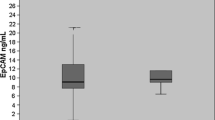Abstract
The incidence of malignant melanoma has been steadily increasing over the past decades. CD 44 is a transmembrane glycoprotein which is implicated in a number of adhesive and migratory events. Downregulation of CD 44 is implicated in the metastatic process. P-Selectin is a member of the selectin family of cell surface molecules. The levels of P-Selectin in biological fluids may be elevated in subjects with a variety of pathological conditions. In malignant melanoma, elevation of the plasma level of soluble intercellular adhesion molecule-1 (sICAM-1) has been associated with a reduction in disease-free survival. This study was performed to investigate the differences in the serum concentrations of the adhesion molecules in patients with malignant melanoma.The study group consisted of 52 patients with malignant melanoma and 20 healthy subjects. No meaningful difference was observed for P-selectin and sICAM 1 levels. A statistically significant decrease was observed in the cancer patients for serum CD 44 levels.
Similar content being viewed by others
References
Altemonte M, Colizzi F, Esposito G, et al: Circulating intercellular adhesion molecule 1 as a marker of disease progression in cutaneous melanoma. N Engl J Med 327–959, 1992.
Borland G, Ross JA, Guy K: Forms and function of CD 44. Immunology 9:139–148, 1998.
Guo YJ, Ma J, Wang JH, et al: Inhibition of human melanoma growth and metastasis in vitro by anti CD 44 monoclonal antibody. Cancer Res 54:1561–1565, 1994.
Harning R, Mainolfi E, Bystryn JC, et al: Serum levels of circulating ICAM-1 in human melanoma. Cancer Res 51:5003–5005, 1991.
Hart I, Birch M, Marshall JF: Cell adhesion receptor expression during melanoma progression and metastasis. Cancer Metastasis Rev 10:115–130, 1991.
Haynes BF, Hale LP, Patton KL, et al: Measurement of an adhesion molecule as an indicator of inflammatory disease activity. Up-regulation of the receptor for hyaluronate (CD44) in rheumatoid arthritis. Arthritis Rheum 34:1434–1443, 1991.
Herrlich P, Zöller M, Palls ST, et al: CD 44 splice variants: metastases meet lymphocytes. Immunol Today 14:395–399, 1993.
Kageshlta T, Yoshii A, Kimura T, et al: Clinical relevance of ICAM-1 expression in primary lesions and serum of patients with malignant melanoma. Cancer Res 53:4927–4932, 1993.
Letner C: Introduction to statistics statistical tables: Geigy scientific tables. CIBA-GEIGY Ltd. Basel, Switzerland, 93:1982.
Ley K, Tedder TF: Leukocyte interactions with vascular endothelium. New insights into selectin-mediated attachment and rolling. J Immunol 155:525–530, 1995.
Mackay CR, Terpe HJ, Stauder R, et al: Expression and modulation of CD44 variant isoforms in humans. J Cell Biol 124:71–82, 1994.
Manten-Horst E, Danen EHJ, Smit L, et al: Expression of CD44 splice variants in human cutaneous melanoma and melanoma cell lines is related to tumor progression and metastatic potential. Int J Cancer 64:182–188, 1995.
Nooijen PT, Westphal JR, Eggermont AM, et al: Endothelial PSelectin expression is reduced in advanced primary melanoma and melanoma metastasis. Am J Pathol 152:679–682, 1998.
Price EA, Coombe DR, Murray JC: Endothelial CD 44H mediates adhesion of a melanoma cell line to quiescent human endothelial cells in vitro. Int J Cancer 64:513–518, 1996.
Ristamaki R, Joensuu H, Jalkanen S Does soluble CD44 reflect the clinical behavior of human cancer. Curr Top Microbiol Immunol 213:155–166, 1996.
Schadendorf D, Heidel J, Gawlik C, et al: Association with clinical outcome of expression of VLA-4 in primary cutaneous malignant melanoma as well as P-Selectin and E-Selectin on intratumoral vessels. J Natl Cancer Inst 87:366–371, 1995.
Schadendorf D, Diehl S, Zuberbier T, et al: Quantitative detection of soluble adhesion molecules in sera of melanoma patients correlates with clinical stage. Dermatology 192:89–93, 1996.
Sliutz G, Temfer C, Winkler S, et al: Immunohistochemical and serological evaluation of CD44 splice variants in human ovarian cancer. Br J Cancer 72:1494–1497, 1995.
Sy MS, Mori H, Liu D: CD44 as a marker in human cancers. Curr Opinion Oncol 9:108–112, 1997.
Tan PH, Santos EB, Rossbach HC, et al: Enhancement of natural killer activity by an antibody to CD 44. J Immunol 150:812–820, 1993.
Tedder TF: The selectins: Vascular adhesion molecules. FASEB J 9:866, 1995.
Viac J, Gueniche A, Faure M, Claudy A. Soluble intercellular adhesion molecule 1 and malignant melanoma. Cancer Lett 72:191–194, 1993.
Author information
Authors and Affiliations
Corresponding author
Additional information
This work has been supported by the Istanbul University Research Fund (Project Nr. 1017/250897).
Rights and permissions
About this article
Cite this article
Yasasever, V., Tas, F., Duranyildiz, D. et al. Serum levels of the soluble adhesion molecules in patients with malignant melanoma. Pathol. Oncol. Res. 6, 42–45 (2000). https://doi.org/10.1007/BF03032657
Received:
Revised:
Accepted:
Issue Date:
DOI: https://doi.org/10.1007/BF03032657




